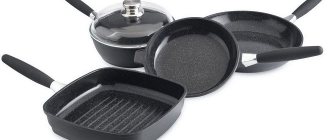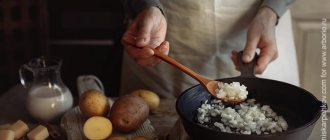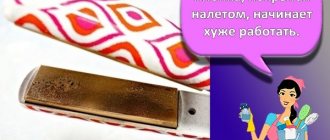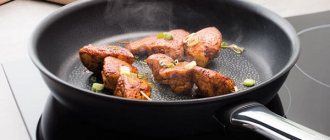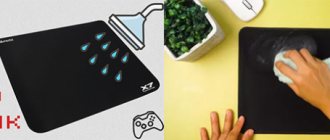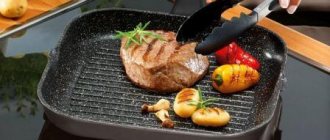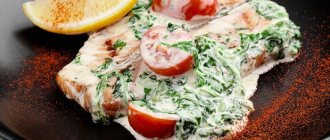A non-stick frying pan is a modern kitchen utensil that is found in almost every kitchen. Thanks to the coating, food does not stick to the inner surface of the cookware, and the food turns out more healthy. It is not necessary to use oil for frying in such pans, so dishes cooked on a non-stick coating can be safely classified as healthy food.
The disadvantage of protective coating is its fragility. The coating is easy to scratch and damage. The article will tell you whether non-stick cookware is dangerous, whether it is possible to use frying pans with a damaged inner layer, and how to restore a Teflon frying pan.
Are non-stick cookware dangerous?
The non-stick coating on the inside of the pan allows you to cook healthy food, but under certain conditions it can become dangerous.
Myths and facts
There is a myth that any non-stick coating is hazardous to health. However, in reality, only a scratched Teflon coating is dangerous, since it contains chemical elements. They penetrate into food if the surface coating layer is broken.
There is also a myth that frying pans with natural coating (made of stone, diamond, ceramics, titanium) are so durable that they are not afraid of contact with metal objects. There is an opinion that such utensils can be used without fear for your health. The natural coating is really durable, but it can be damaged if deliberately impacted with a metal object. Damaged non-stick coating can no longer be called completely safe.
Important. The natural coating itself does not pose any threat, but scratches expose the metal from which the frying pan is made. When heated, metal releases harmful substances and gives food an unpleasant taste.
Resistance to damage
With proper care, all non-stick coatings are quite resistant to damage. But each type of coating has its own characteristics. Ceramic coating does not like sudden temperature changes. It is not shock-resistant, so if you drop such a frying pan, chips and cracks may appear on it. The Teflon coating is very susceptible to the use of metal accessories that can scratch the non-stick surface.
Stone coatings are less susceptible to mechanical damage compared to conventional Teflon. But they are afraid of temperature changes. Therefore, such pans cannot be placed from the refrigerator on fire or washed hot under cold water. The titanium non-stick coating is wear-resistant and resistant to scratches and damage. The main criterion for choosing a high-quality coating for dishes is the reliability and authority of the manufacturer. Well-known brands produce high-quality tableware that meets all environmental and safety requirements.
How to use a frying pan with a damaged non-stick coating
If it is not possible to urgently replace a damaged frying pan, it is recommended to use it as carefully as possible:
- stir food only with a wooden or silicone spatula;
- do not scrub dishes with a metal sponge;
- do not use abrasives for washing dishes;
- Do not wash the pan in the dishwasher;
- do not heat the dishes to temperatures exceeding 250°C;
- Do not use the pan for baking in the oven;
- Wipe dishes with sunflower oil once a week.
How does non-stick cookware differ from other coatings?
Modern cookware gained popularity in the late 1800s as homes transitioned from cooking in a fireplace or around a fire to cooking on camp stoves. While previous cookware had legs and/or handles for use over an open fire, ovens created the need for flat-bottomed pans and pans. Cast iron served this need. Iron was cheap, available and durable.
The coating is made from molten cast iron poured into molds made of compacted sand or a sand mixture. When molten iron cools, it takes the shape of a mold. Once sufficiently cooled, the cookware is released from the sand mold. This explains the somewhat rough surface of most cast iron skillets, although more modern items are often less polished than their vintage counterparts.
The invention of nonstick pans negatively impacted the cast iron cookware industry in the 1960s. Consumers enjoyed the new space-proof non-stick Teflon surfaces, and few cast iron cookware manufacturers survived. Those who have used their own recipes to formulate the iron used in their brands have largely reworked them. Today's cast iron cookware is often made and pre-seasoned before being sold on the market.
Some people believe that cast iron is easy to maintain, others avoid it because they have heard that it has high maintenance costs. Should I wash it with soap? Is there a specific oil that is best for protection? In this section, we'll look at some of these ideas about cast iron cookware and try to determine which approach is best. It's often a matter of personal preference.
Is cast iron generally easy or difficult to maintain? This question often comes up because too often cast iron has not been properly seasoned or has been poorly maintained in the past. While it is nearly indestructible, just like everything else in the kitchen, it is truly a matter of concern. Cast iron does not need to be treated to prevent rust, which already makes it a favorite in many kitchens.
If you see cast iron cookware that is rusty, chipped, or shiny, chances are it hasn't been taken care of properly, potentially since it was originally seasoned. Keep in mind, however, that even some of the most heavily used cast iron skillets can be fully refurbished, giving you years of extra use.
Is it possible to repair damaged non-stick coating?
It is impossible to restore damaged non-stick coating on a frying pan at home. Creating the inner protective layer of cookware is a high-tech process that can only be carried out at the enterprise.
The non-stick layer is a mixture of different components, which is applied in liquid form to the surface of the frying pan. For example, stone spray is fine stone dust mixed with a binder. This coating is applied to cookware under high pressure. The pans are then dried in special chambers.
It is impossible to repeat these manipulations at home.
Restoring pans with a special mixture
Another way to restore a Teflon frying pan is to prepare a special mixture. Mix half a cup of white vinegar, two tablespoons of baking soda, and a cup of water directly into the pan (the one you want to fix). Let the mixture combine and place the pan on the stove. Heat the mixture to a boil and boil for 10 minutes. You can clean the pan and then re-treat it by rubbing vegetable oil directly onto the surface. Do the rub while it is still warm or at least at room temperature. Reprocessing is important if you want to get your non-stick pan back again.
What is Teflon
Teflon is a polymer of tetrafluoroethylene (PTFE), a plastic that has unique properties and is widely used not only in the production of tableware, but also in equipment. Teflon is sprayed onto the inside of pans to create a non-stick effect.
Unique properties of Teflon:
- low coefficient of sliding friction;
- high thermal conductivity and frost resistance;
- does not attract water and fat molecules;
- chemical resistance is higher than that of gold and platinum;
- melting temperature from +260°C.
Restoring the Teflon coating on a frying pan is impossible. Damaged dishes are disposed of.
How harmful is it to human health?
Manufacturers of non-stick cookware assure that the products are safe if used carefully.
A Teflon-coated frying pan can be harmful in a number of cases:
- if you heat it above +230°C;
- if you scratch it.
Overheated Teflon releases harmful substances, transferring them to food. The same thing happens with scratched material. The polymer is not excreted from the body for a long time and causes serious harm to health.
Recovery with spray
There are several ways to restore a frying pan. The first is to use non-stick cooking spray. You need to wash the pan thoroughly and make sure there are no food residues left on the surface. Try to dry it well. Buy dishwashing spray from home improvement stores (or online). Use spray on the pan. Make sure the inside of the pan has an even, thick coating. Then preheat the oven to 200 degrees Celsius for 10 minutes.
Place the pan in the oven and leave for 45 minutes. Turn off the oven. Leave the pan inside the oven and let it cool. No need to open the oven. If the pan is completely cool, you can wash it again. Use a sponge and dish soap. When storing your pan, make sure you use a divider to prevent anything from scratching the surface.
Choosing a frying pan that is safe for health
Let's look at the types of coatings and their effects on health.
Titanium
Titanium coating is a mixture of titanium dust with another substance. There are the following options for this spraying:
- titanium + teflon;
- titanium + ceramics;
- titanium + polymer.
The second type of protective layer, when metal dust is mixed with ceramics, is considered the safest. In this case, the frying pan receives an absolutely natural and safe coating. These pans are durable and lightweight.
Ceramics
Ceramics is an environmentally friendly coating that is also safe for human health. These pans are ideal not only for frying, but also for baking in the oven.
It is important to remember that ceramic protective coating is quite fragile. It can not only be scratched, but also broken.
Teflon
Fully synthetic coating, safe only if all operating conditions are strictly observed. Experts recommend buying such utensils on a limited budget or as temporary kitchen utensils, for travel or at the cottage.
Making a Teflon coating for a frying pan with your own hands
If the Teflon frying pan begins to burn, this indicates damage to the protective layer or its poor quality. It is impossible to completely restore the original properties of the coating, but you can try to correct the situation at home. To do this, boil a mixture of water, laundry soap and a small amount of vinegar in a frying pan for 15 minutes.
After draining the solution, the dishes should be rinsed, gently rubbed with a soft sponge and dried. Grease the prepared surface with oil and start frying. If the procedure does not work, it is worth applying a Teflon coating, which will be done efficiently and quickly by specialists.
How to clean the outside of a Teflon frying pan
Cleaning the outside is much easier, since here you no longer have to worry about scratching the coating; the outside is much more resistant to various chemicals and powders.
The outside of such utensils is usually made of polished steel or aluminum and coated with enamel. You can remove greasy deposits using the following popular store-bought products:
- "Shumanit" liquid;
- "Mr. Cheester" - spray;
- "Domestos" - gel;
- "Fairy Power" - spray.
Of all the above remedies, the most effective is Schumanite. However, during the cleaning process, you must wear gloves on your hands, because its composition contains a large amount of chlorine and other ingredients harmful to the skin.
What happens if you eat non-stick coating?
Teflon, one of the most popular non-stick coatings, is indeed not harmless. If the exposure temperature recommended by the manufacturer is exceeded, or the coating is damaged, then its use will be truly dangerous; harmful substances, including carcinogenic ones, will begin to be released.
Interesting materials:
Is it possible to restore contacts after a factory reset? Is it possible to recover a micro SD card? Is it possible to restore muscles? Is it possible to restore unsaved changes in Word? Is it possible to restore a patent if it has been revoked? Is it possible to restore correspondence on Skype? Is it possible to restore correspondence on WhatsApp? Is it possible to restore a shrunken wool item? Is it possible to restore a wool item? Is it possible to recover a screenshot?
How to clean the inside of a Teflon frying pan
Teflon itself is delicate and is quickly deformed by hard brushes and iron devices. Therefore, when cleaning such a frying pan, you need to arm yourself exclusively with soft sponges, rags and non-abrasive products.
It is also advisable not to use various powdered preparations. There are several excellent tools available that will quickly remove greasy deposits from a frying pan without damaging the inner surface.
Using food baking powder
At first glance, the solution may seem unexpected, but nevertheless it is effective. Baking powder, which pastry chefs add to the dough when baking baked goods, really helps clean a Teflon frying pan from grease and soot.
You need to take 4 tbsp. spoons of baking powder, dissolve in 350 ml of water. Pour the mixture into a dirty frying pan, place over medium heat and boil from the moment of boiling for 15-20 minutes, depending on the complexity of the contamination. After this, drain the solution and wash the pan with detergent and a soft sponge.
Advice! Baking powder can be replaced with regular soda. Just take a little more quantity: 5 tbsp. spoons per 1 liter of water.
How to wash with laundry soap
You can clean a Teflon frying pan in almost the same way with laundry soap. Only the soap solution does not need to be boiled, just slightly heated over low heat and left in the pan for 60 minutes to soak.
Pre-grind the soap using a grater and dissolve it in a small amount of water. After soaking, drain the water and rinse the pan with a sponge.
Clean with vinegar
To clean a Teflon frying pan, it is better to use 9 percent vinegar. Pour water into the pan to about half the volume, add 2 tbsp. spoons of vinegar.
Boil the solution over low heat for 20 minutes. Remove the pan from the heat and set aside until completely cool. Drain the mixture and rinse the container with running water and dish soap.
Preventive measures to preserve the polymer layer
In order for a Teflon frying pan to last as long as possible, you should pay attention to the rules of its operation:
- do not use metal utensils;
- It is not recommended to heat dishes too much without food;
- it should be cleaned with a soft sponge, but a hard brush will probably leave microscopic scratches, which will subsequently destroy the layer.
A new frying pan can be subjected to the following preventive procedure:
- fill the container with water to the brim;
- put on the stove and boil for 10-12 minutes;
- drain the liquid;
- Add vegetable oil to the bottom and carefully distribute it over the entire surface and walls.
Such an event will protect the dishes from damage.
Caring for non-stick coating
As mentioned earlier, the non-stick surface does not last forever. However, you can extend its life and prevent premature wear (or damage) by caring for your pan properly. If you don't want to deal with how to restore your nonstick pan, here are a few things to do after cleaning:
- Avoid using the dishwasher to clean the pan. Although most manufacturers claim that their products are dishwasher safe, it is best to avoid them at all costs. The best way to clean a pan is to use a sponge and soapy water. In the dishwasher, the pan will collide with utensils and other utensils, increasing the likelihood of scratches and damage.
- Avoid using metal utensils when cooking in a Teflon pan. Metal utensils will scratch the surface. It is better to use wooden or silicone utensils. This will save you from burning and damage.
- Pour fat (only a small amount), such as oil, into the pan before turning on the heat. Distribute it evenly. This will add a greasy layer and protect the non-stick surface. Don't add oil after the pan is hot because it won't help with the non-stick surface.
- It would be wise if you also knew when to replace the pan. In general, pans can last five years. Some products may last longer. But you should also have newer pans that you can use instead of the old ones. Knowing how to restore a nonstick pan is helpful, and you can actually save a lot of money in the process.
While caring for cast iron cookware may be a little different than caring for aluminum, steel, or copper cookware, using it is not particularly difficult. In fact, quite the opposite, many fans of cast iron cookware actually believe that care is much easier than their counterparts made from other materials. Cast iron holds up better to wear and tear and does not require as much maintenance as copper cookware. Even with repeated use, cast iron is durable.
If there is one cast iron cookware issue that is intensely debated, it is the soap/no soap dilemma. Some people believe that soap can strip away the oils that protect the pan, which can negatively impact your cookware. Others can't imagine putting away dishes that haven't been cleaned with soap.
Keep in mind that heating oil in a cast iron skillet will cause polymerization to occur during cooking. This is a chemical change that bonds the oil to the metal, forming a protective layer. This layer cannot be removed by simply cleaning with dish soap; the properties of the soap are not strong enough.
However, there are those who believe that the seasoned layer actually adds flavor from previously cooked food to other foods cooked in the same cast iron. While using dish soap won't affect the true protective layer in the pan formed by the polymerization of the oil, there's nothing wrong with not using soap. Just make sure that food particles and debris are completely removed and that your cookware is wiped clean. Once the food is removed and the pan is wiped down, the remaining oil can serve to further protect the pan the next time it is used. This can also be achieved by washing with soap after use and then applying a new layer of oil, which can help provide further protection the next time you use it. The bottom line is that “to wash or not to wash” is largely a decision that can be made based on personal preference and comfort level.
Which oil is better?
Another debate that has gone on for years is whether one oil is better than another for cooking with cast iron cookware. Opinions range from old school lard to today's modern oil blends created specifically for hardening cast iron.
For some, grapeseed oil is a good choice due to its high smoke point. The general consensus today is that any polyunsaturated oil works best. These oils include corn, sunflower and safflower. Some major cast iron cookware manufacturers, such as Lodge Cast Iron, Tramontina Cast Iron, and FINEX Cast Iron, recommend vegetable oil, shortening, or even canola oil. Some cooks prefer coconut oil because it contains less fat than some other oils.
Why shouldn't you overheat a Teflon frying pan?
It's safe to use Teflon
and
Teflon
coating at temperatures up to 200 C. Already at this temperature, harmful substances begin to be released from the coating, such as hydrogen fluoride, carbon monoxide and dioxide, fluorphosgene (a substance 10 times more toxic than phosgene), tetrafluoroethylene, perfluoroisobutylene.
Interesting materials:
How long can you walk in the cold? How long can you walk with a tampon after swimming? How long can a banana be stored? How long can baby meat puree be stored? How long can baby vegetable puree be stored in the refrigerator? How long can Fenistil be stored after opening? How long can you store ready-made cakes for Napoleon? How long can persimmons be stored in the refrigerator? How long can canned compotes be stored? How long can the Fitosporin stock solution be stored?

